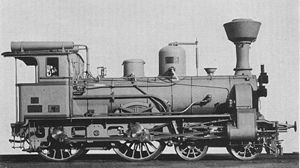kkStB 4
| kkStB 4 BBÖ 4 / ČSD series 254.2 / PKP Od13 / FS 543 |
|
|---|---|
|
kkStB 4.69
|
|
| Numbering: | BWB A 50–53 kkStB 01–199, 201–214 |
| Number: | 213 |
| Manufacturer: | Wr. Neustadt , Floridsdorf , Krauss / Linz , StEG |
| Year of construction (s): | 1885-1897 |
| Retirement: | BBÖ: 1930 ČSD: 1937 |
| Axis formula : | 2'B n2 |
| Gauge : | 1435 mm ( standard gauge ) |
| Length: | 8,870 mm |
| Height: | 4,564 m |
| Fixed wheelbase: | 2,500 mm |
| Total wheelbase: | 5,900 mm |
| Service mass: | 45.5 t |
| Friction mass: | 27.0 t |
| Top speed: | 80 km / h |
| Driving wheel diameter: | 1,820 mm |
| Impeller diameter front: | 1,034 mm |
| Cylinder diameter: | 435 mm |
| Piston stroke: | 632 mm |
| Boiler overpressure: | 11 bar |
| Number of heating pipes: | 186 |
| Grate area: | 2.06 m² |
| Radiant heating surface: | 7.00 m² |
| Tubular heating surface: | 108.00 m² |
| Tender: | 8 , 10 , 13 , 18 , 22 , 31 , 34 , 35 , 36 , 40 , 66 |
The steam locomotive series kkStB 4 was a fast train - Tender Locomotive series of Imperial Austrian State Railways (kkStB), the locomotives were originally derived from various nationalized private companies, have been ordered for that of the kkStB or procured by the kkStB itself.
history
The 4.01–180 were procured by the kkStB itself, the 4.181–193 were created through conversion from kkStB 3 .01–13. The 4,194-195 were ordered by the kkStB for the Lemberg-Chernivtsi-Jassy Railway (LCJE) and the 4,196-199 came from the Bohemian West Railway (BWB). The four BWB machines were originally named GERSTNER , REDTENBACHER , SCHNIRCH and VIGNOLES . The 4.201–214 were finally created in 1904 by renumbering from the kkStB 104.01–14, of which the first 13 were originally procured by the kkStB for the Kaiser-Franz-Josephs-Bahn . The 4,214 was used on the Niederlindewiese - Barzdorf route. The private railways had their locomotives built based on the kkStB series. For the sake of completeness, it should be noted that 4.100–199 1904 emerged from 5.00–99 by renumbering.
Class 4 was the first express train locomotive procured by the kkStB itself, but it was still based heavily on existing models. With the machines taken over and modified by private railways, this series reached a number of 213 locomotives. The locomotives of this series were delivered by the Wiener Neustädter Lokomotivfabrik , the Lokomotivfabrik Floridsdorf , Krauss in Linz and the Lokomotivfabrik der StEG .
The Vienna-Aspang railway had similar locomotives, which were designated as series IIa .
After the First World War , representatives of the 4 series came to the PKP as series Od13 , to the ČSD as series 254.2 , to the FS as series 543 , to the railways of the Kingdom of Serbs, Croats and Slovenes and CFR , which they did not have before they were retired assigned their own series number, and to the BBÖ while retaining the series number. The ČSD withdrew their machines until 1937, the BBÖ put them out of service until 1930.
At the Deutsche Reichsbahn , the machines still in existence were given the class designation 36.70 during the Second World War .
The dimensions given in the table are typical values of this thrown together series.
literature
- Karl Gölsdorf: Locomotive construction in old Austria 1837–1918 . Slezak publishing house, Vienna 1978, ISBN 3-900134-40-5 .
- Helmut Griebl, Josef Otto Slezak, Hans Sternhart: BBÖ Lokomotiv-Chronik 1923–1938 . Slezak publishing house, Vienna 1985, ISBN 3-85416-026-7 .
- Heribert Schröpfer: Locomotives for Austrian railways - steam locomotives BBÖ and ÖBB . alba, Düsseldorf 1989, ISBN 3-87094-110-3 .
- Johann Stockklausner: Steam company in old Austria . Slezak Verlag, Vienna 1979, ISBN 3-900134-41-3 .
- Johann Blieberger, Josef Pospichal: The kkStB traction vehicles, volume 1. The rows 1 to 228 . bahnmedien.at, 2008, ISBN 978-3-9502648-0-7 .
